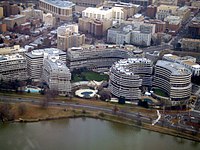
Photo from wikipedia
Abstract Quantum chemical calculations have been employed to study kinetically stable cationic clusters, wherein the monovalent cations are trapped by hydrogen bonding despite strongly repulsive electrostatic forces. We calculated linear… Click to show full abstract
Abstract Quantum chemical calculations have been employed to study kinetically stable cationic clusters, wherein the monovalent cations are trapped by hydrogen bonding despite strongly repulsive electrostatic forces. We calculated linear and cyclic clusters of the hydroxy‐functionalized cation N‐(3‐hydroxypropyl) pyridinium, commonly used as cation in ionic liquids. The largest kinetically stable cluster was a cyclic hexamer that very much resembles the structural motifs of molecular clusters, as known for water and alcohols. Surprisingly, strong cooperative hydrogen bonds overcome electrostatic repulsion and result in cationic clusters with a high net charge up to Q=+6e. The structural, spectroscopic, and electronic signatures of the cationic and related molecular clusters of 3‐phenyl‐1‐propanol could be correlated to NBO parameters, supporting the existence of “anti‐electrostatic” hydrogen bonds (AEHB), as recently suggested by Weinhold. We also showed that dispersion forces enhance the cationic cluster formation and compensate the electrostatic repulsion of one additional positive charge.
Journal Title: Chemphyschem
Year Published: 2018
Link to full text (if available)
Share on Social Media: Sign Up to like & get
recommendations!